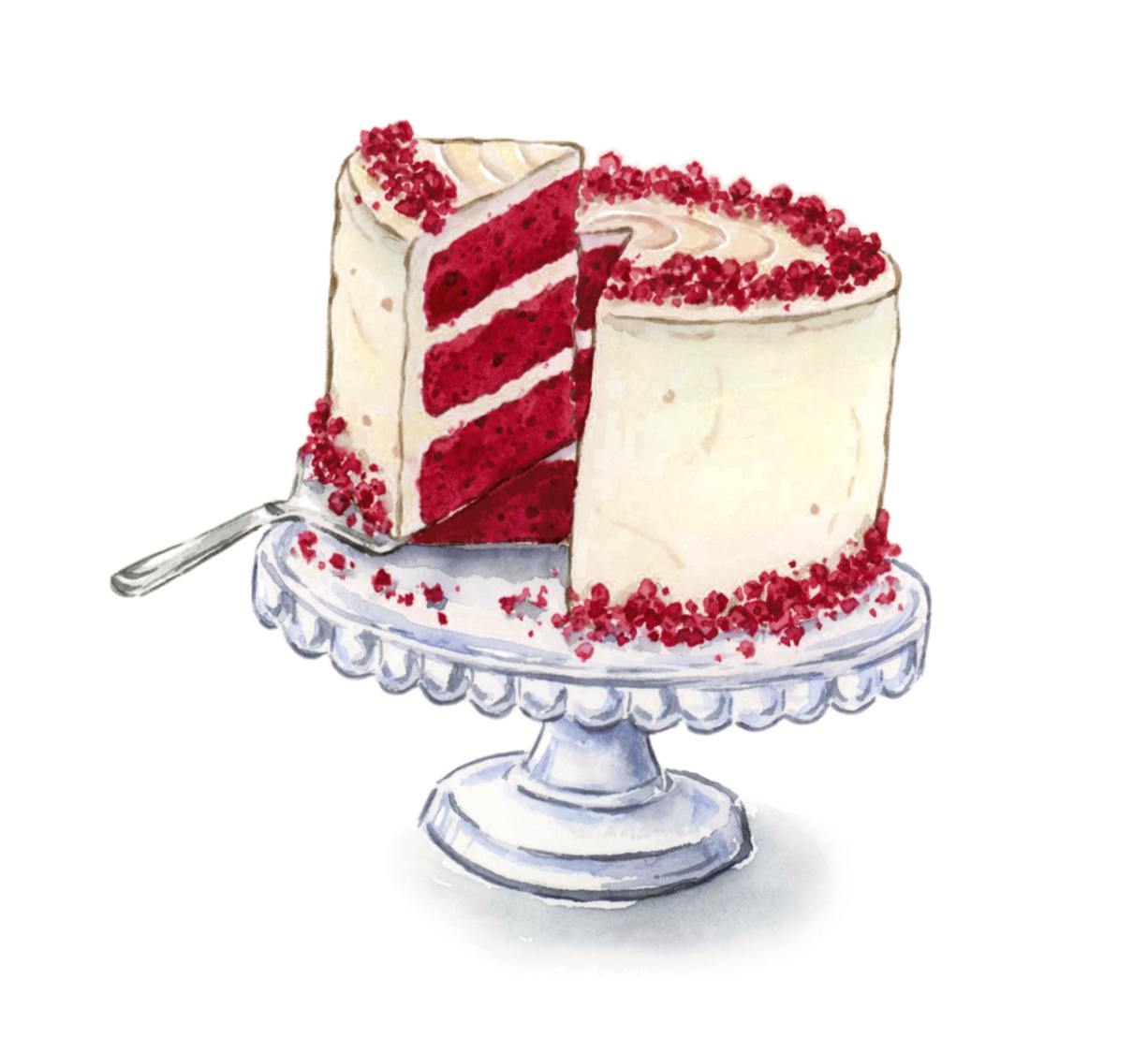
I will admit to having been dismissive of red velvet cake in the past, considering it to be bland in flavour and garish in colour. It tended to come in cupcake form with towering hats of super-sweet buttercream, which made it unpleasant and difficult to eat. The cult love for red velvet, inspiring scented candles and lip balms all smelling of synthetic vanilla, always struck me as a bit naff – the preserve of teenage girls queueing outside Instagram-bait bakeries. Why would you plump for a red velvet cupcake when you could have coffee and walnut or a lemon syrup-soaked sponge or a nobbly carrot cake? Red velvet was a cake for people who didn’t really like cake.
I was, however, doing the poor old red velvet cake a disservice because its massive popularity has resulted in most of today’s cakes bearing little relation to the true recipe.
A red velvet cake is not just a red sponge cake: the ‘velvet’ refers to the fineness of the crumb and is a term that has been used for cakes, pancakes and scone-like shortcakes since the 1800s. The addition of cocoa to the mixture created a very smooth soft crumb, hence the name. The exact origins of the cake are unclear, although it is always listed as being a classic of the American South, and recipes for cakes combining buttermilk and cocoa date back to the 19th century. The ‘red’ was originally the effect produced by the reaction between buttermilk and vinegar on the one hand and the cocoa on the other – although it’s fair to say that the original colour would have been more burgundy than fire engine.
Now, however, most cocoa powder is Dutch-processed, so that reaction doesn’t take place. As a result, today’s red velvet cakes are dyed red – and are far redder than they once were. Some even miss out the cocoa entirely to ensure the brightest of reds, unsullied by the dark cocoa.
The cake was made famous in the 1920s when the Waldorf-Astoria hotel in New York made it one of its signature desserts. Ten years later, synthetic food dyes were invented and the Adams Extract company developed a recipe for the brighter, redder modern incarnation in an attempt to market its products using an existing and much-loved cake.
Made properly, the cake’s flavour is subtler than its colour scheme: vanilla-scented and slightly tangy from the buttermilk, the amount of cocoa is small enough that it never tips into chocolate cake territory but tempers any overwhelming sweetness with its bitterness. It’s peculiar that red velvet has become a default flavour for American-style cupcakes, as not only were the Waldorf-Astoria red velvet cakes layered, but the more balanced ratio of cake to icing in a layer cake makes complete sense. The nature of red velvet also lends itself perfectly to that form: the buttermilk sponges won’t collapse as you stack them and the traditional icing is easy to apply. If you’ve been nervous stacking and icing big cakes in the past, this is the perfect place to start.
This is no cutesy diminutive cupcake. No, this is a stately, tall layered cake: a monolith that will feed a party
I have gone traditional here, using lots of buttermilk for the tenderest, tangiest of sponges, a spot of cocoa powder and just enough food colouring to ape the original colour reaction. And this is no cutesy, diminutive cupcake. No, this is a stately, tall layered cake: a monolith that will feed a party.
Today, it is all but accepted that the icing for a red velvet cake should be cream cheese-based, but originally the classic coating was called ermine icing. An old-fashioned butter-cream, also called ‘boiled milk frosting’, it’s rarely used today but I am a convert. It’s made with a roux of flour, sugar and milk, boiled until thick and custardy, and then beaten into soft butter. Lighter in texture and less sweet than icing-sugar buttercreams, it’s brilliantly stable, silky and bright white.
I urge you to have a crack at this ermine. Where cream cheese icing can be finickity, ermine is lovely to work with and gives a beautiful, delicate finish to a handsome cake.
Makes 1 tall, 8-inch cake
Takes 30 minutes, plus cooling
Bakes 35-40 minutes
For the sponge
- 180g unsalted butter, soft
- 450g caster sugar
- 3 eggs
- 25g cocoa powder
- 1 tbsp red gel food colouring
- 1.5 tsp vanilla extract
- 360 ml buttermilk
- 450g plain flour
- 1.5 tsp bicarbonate of soda
- 1½ tbsp white vinegar
For ermine icing
- 300g granulated sugar
- 65g plain flour
- 400ml whole milk
- 400g butter
- Line three 8in tins with baking paper, and preheat oven to 170°C.
- Cream the butter and sugar together until pale and fluffy, then add the eggs one by one.
- Add cocoa powder, vanilla extract and half the buttermilk, followed by half the flour, and then repeat with the rest. Stir through the food colouring then bicarbonate of soda and vinegar.
- Divide the mixture between the tins and bake for 35 minutes. Leave to cool for 15 minutes, then remove and cool on a rack.
- To make the ermine icing, place sugar and flour in a pan over a medium heat, and pour in the milk. Whisk until thick. Decant to a plate, cover with clingfilm touching the surface, and leave to cool. Whip the butter until it is smooth, then slowly beat in the milk-flour paste with the vanilla extract and salt. Whisk again.
- Spread the icing on to the first layer of cake; place the second layer on top and spread with more icing. Smooth the icing in a thin layer over the whole cake, and refrigerate for 20 minutes.
- Finish with a thicker layer of icing smoothed all over the cake.








Comments